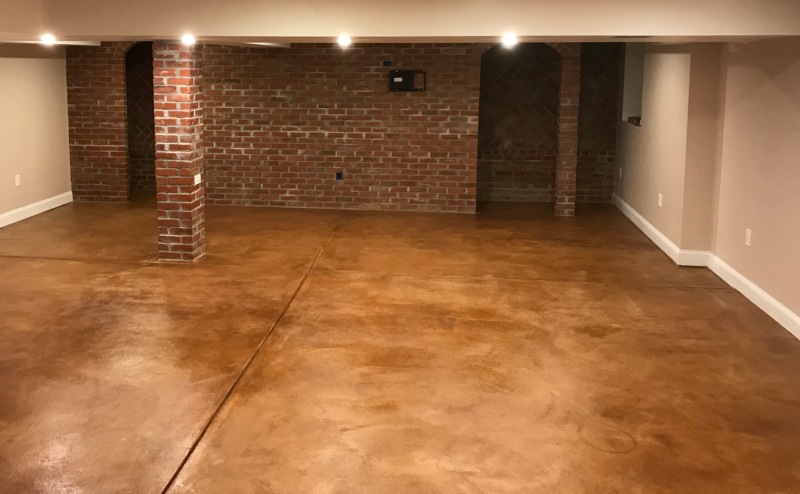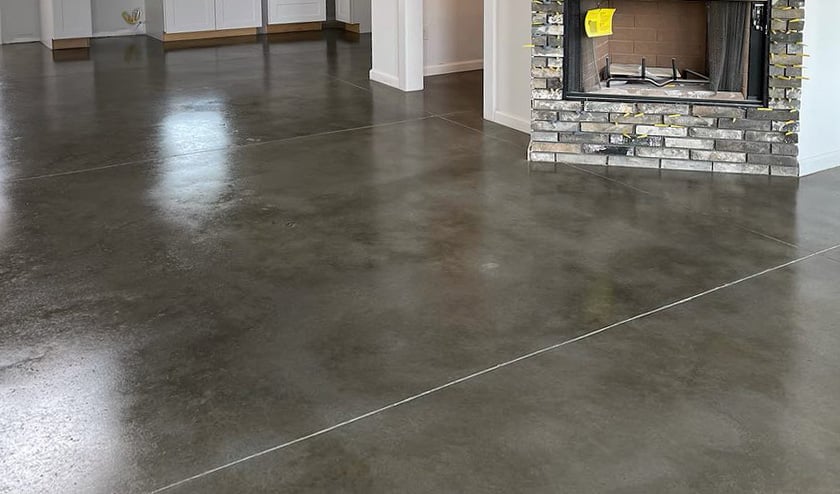Tips for selecting the best stained concrete company
Comprehending the Different Kinds Of Stained Concrete for Your Next Task
Stained concrete deals different options that deal with various aesthetic and practical needs. Each type offers distinctive qualities that influence the last appearance and toughness of the surface area. Recognizing these distinctions is essential for any person preparing a job. From abundant, chemical reactions of acid-based stains to the dynamic uniformity of strong shade stains, the options can significantly affect the result. What aspects should one think about when choosing the excellent tarnish for their certain demands?
Overview of Stained Concrete
Stained concrete offers as a versatile flooring choice that can improve the visual allure of numerous rooms. This method involves applying a coloring representative to the surface of existing concrete, enabling a wide spectrum of style opportunities. Stained concrete is popular in both property and industrial atmospheres, supplying a resilient and low-maintenance service that can imitate the appearance of natural materials like rock or floor tile.
The staining procedure can be implemented making use of water-based or solvent-based products, each supplying distinctive visual impacts. The last appearance is affected by aspects such as the initial concrete surface area, the sort of tarnish made use of, and the application method. Stained concrete not only enhances insides and outsides but also advertises sustainability by rejuvenating existing concrete structures. Consequently, it has gotten traction amongst house owners and developers seeking both performance and style in their flooring choices.
Acid-Based Stains: Features and Benefits

Special Shade Variations
Concrete surface areas can transform substantially with the application of acid-based stains, which provide a rich palette of distinct color variants. These stains pass through the concrete, responding chemically to generate dynamic earth tones that vary from deep browns and reds to soft eco-friendlies and blues. The resulting hues are commonly variegated, creating a natural, marble-like look that boosts the concrete's character. Each application yields distinctive outcomes because of variations in the concrete's structure and the staining strategy made use of, making every task distinct. In addition, acid-based stains can be layered or integrated with other strategies to create tailored designs, enabling individual expression. This adaptability makes acid-based stains a prominent selection for both household and industrial applications.
Chemical Reactions Explained
While several variables add to the effectiveness of acid-based stains, the underlying chemical responses play a necessary duty in their distinct attributes and benefits. These stains primarily include water, acid, and metal salts. When related to concrete, the acid reacts with the calcium hydroxide in the cement, developing a chemical transformation that causes long-term shade modifications. The metal salts permeate the surface area and bond with the concrete, permitting a large range of shades and tones. This reaction not only enhances visual allure but additionally supplies durability, making the shade immune to fading and wear. In addition, acid-based stains can produce a variegated coating that resembles all-natural stone, additional enhancing their popularity for attractive concrete applications.
Surface Area Preparation Relevance
Achieving excellent outcomes with acid-based stains pivots on extensive surface preparation. This necessary step assurances that the concrete surface area is tidy, without contaminants, and properly profiled for suitable stain absorption. Any kind of existing sealers, dust, or oils can hinder the chemical response that produces the wanted color and surface, leading to uneven or patchy results.
Before using the tarnish, the concrete must be mechanically cleansed or pressure washed, followed by a complete examination for fractures or flaws that might require repair work. Furthermore, verifying the surface area is appropriately dried will certainly boost stain adherence. By prioritizing these primary procedures, the longevity and vibrancy of acid-based stains can be greatly boosted, causing a much more aesthetically pleasing and sturdy surface.
Water-Based Stains: Functions and Benefits

Water-based stains pass through the concrete, offering a much more translucent coating that highlights the natural appearance and variations of the surface below. They are offered in a large variety of colors, enabling innovative adaptability in layout. Furthermore, water-based stains are simpler to clean up, needing only water and soap, which streamlines the blog application procedure.
Their quick drying time enhances effectiveness, making them a useful option for both do it yourself enthusiasts and professionals. On the whole, water-based stains provide an appealing combination of aesthetic versatility and user-friendly homes, making them a preferred alternative for concrete improvement tasks.
Solid Color Stains: Vibrant Alternatives for a Bold Look
Solid color stains provide a reliable solution for those seeking to develop a bold site web and lively aesthetic on concrete surfaces. These stains give an uniform pigmentation that can drastically enhance the visual allure of floorings, patios, and driveways. Offered in a large spectrum of hues, strong shade stains permit innovative expression, dealing with various layout preferences.
One of the key benefits of solid shade stains is their capacity to conceal imperfections, supplying a fresh and refined look to maturing concrete - stained concrete floors. Additionally, their formula usually consists of UV-resistant residential or commercial properties, guaranteeing longevity and color retention also in harsh climate condition
Application is straightforward, needing minimal prep work of the concrete surface. When applied, solid shade stains can be secured for added security and sheen, further boosting their aesthetic quality. With their vibrant options, strong shade stains are an outstanding selection for those going for an impactful and natural design.
Semi-Transparent Stains: Achieving Depth and Dimension
Semi-transparent stains supply a special method to boosting concrete surfaces by giving depth and measurement through different color options. Understanding the application strategies is essential for attaining the preferred result, while appropriate upkeep methods assure durability. This area will certainly check out these essential aspects to maximize the advantages of semi-transparent staining.
Color Options Available
A wide array of color options exists for semi-transparent stains, allowing property owners and developers to improve the natural charm of concrete surface areas. These stains can be found in a variety of shades, from natural tones like browns and terracottas to vibrant colors such as blues and greens. The semi-transparent nature of these stains allows the underlying concrete to reveal via, producing an unique deepness and measurement that can match various layout looks. In addition, combining various shades can create personalized tones, making it possible for a tailored try to find each project. This versatility makes semi-transparent stains a preferred selection for both indoor and outside applications, as they can integrate with surrounding components while including aesthetic rate of interest to simple concrete.
Application Techniques Clarified
To accomplish the wanted deepness and measurement with semi-transparent stains, proper application methods are crucial. Surface area preparation is crucial; the concrete needs to be clean and complimentary of any kind of contaminants. This commonly entails power cleaning and repairing any kind of cracks. Next off, picking the ideal applicator, such as a sprayer, roller, or brush, can influence the last appearance. Sprayers enable an extra even application, while rollers can aid attain texture. It is necessary to use the stain in slim, also coats, permitting each layer to completely dry prior to adding another. Manipulating the application strategy, such as differing pressure or utilizing various tools, can produce one-of-a-kind impacts. Finally, sealing the stained surface boosts the vibrancy of the colors while view providing defense.
Upkeep Finest Practices
Regular upkeep is essential for protecting the charm and honesty of surfaces treated with semi-transparent stains. To keep these surface areas, routine cleaning is vital. Making use of a pH-neutral cleaner and a soft-bristle mop will aid get rid of dust and debris without harming the discolor. It is advisable to avoid severe chemicals, as they can degrade the discolor's look. In addition, regular resealing every one to 3 years can safeguard against wear and fading. This process entails cleansing the surface extensively and applying a suitable sealer designed for stained concrete. House owners must likewise check for any kind of signs of discoloration or damage and address these issues promptly to ensure resilient vibrancy and durability. Complying with these best techniques will improve the total life expectancy of semi-transparent stained surface areas.
Impacts and Methods: Personalizing Your Stained Concrete
Tailoring stained concrete involves a range of methods that enhance both looks and performance. Amongst these methods, layering different discolor colors can develop deepness and complexity, permitting special aesthetic results. Methods such as acid staining offer a variegated appearance, while water-based stains supply a more uniform appearance.
Additionally, integrating ornamental patterns, such as stenciling or inscription, can better individualize the surface area, adding detailed styles that satisfy specific tastes. Texturing the concrete, whether through stamping or mop coatings, introduces tactile components that not only boost grip however likewise boost visual rate of interest.
Using sealers can intensify the shade vibrancy and supply defense versus wear. Modification strategies expand past mere shade; they can transform a basic concrete slab into a spectacular focal factor, making it suitable for both domestic and business rooms. Via mindful choice of impacts and techniques, stained concrete can achieve an absolutely customized look.
Maintenance and Long Life of Stained Surfaces
Although stained concrete surface areas are understood for their longevity and visual allure, maintaining their stability is important for ensuring durability. Routine cleansing is essential; sweeping and mopping with a pH-neutral cleaner aids stop dirt buildup and staining. In addition, using a sealant every few years can safeguard the surface from wetness, chemicals, and UV damage, thus boosting its lifespan.
It is also vital to address any type of fractures or chips quickly. Tiny repair services can minimize more wear and tear, protecting the aesthetic and structural top quality of the surface area. For exterior stained concrete, seasonal upkeep, such as getting rid of snow and ice, is essential to stop surface damage from freeze-thaw cycles.
Frequently Asked Inquiries
Can I Tarnish Existing Concrete Surfaces or Only New Ones?
The concern of whether existing concrete surfaces can be stained arises regularly. It is certainly possible to discolor both brand-new and old concrete, offered the surface is properly prepared and complimentary of impurities for ideal adhesion.
The length of time Does the Discoloration Refine Generally Take?
The staining process commonly takes one to three days, relying on factors such as surface area prep work, kind of tarnish, and weather. stained concrete company. Treating time may prolong past first application, influencing the overall duration substantially
Is Stained Concrete Safe for Outdoor Use?
Stained concrete is usually safe for outdoor use, gave it is effectively secured. This securing safeguards versus moisture and UV damage, guaranteeing toughness and safety and security, while additionally boosting the aesthetic charm of exterior areas.
Can I Apply Numerous Discoloration Layers for Different Effects?
Applying multiple stain layers can achieve different effects on stained concrete. It is vital to ensure compatibility between stains and enable correct drying time in between applications to stay clear of unexpected responses or staining.
Exist Any Type Of Shade Limitations for Stained Concrete?
Shade restrictions for stained concrete mainly rely on the type of stain utilized, with water-based stains supplying a wider scheme compared to acid-based stains. local stained concrete. Accomplishing lively colors may call for mindful option and application techniques.